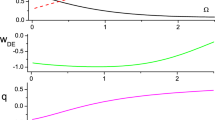Abstract
A recent result by Borchers connecting geometric modular action, modular inclusion and spectrum condition, is applied in quantum field theory on spacetimes with a bifurcate Killing horizon (these are generalizations of black-hole spacetimes, comprising the familiar black-hole spacetime models). Within this framework, we give sufficient, model-independent conditions ensuring that the temperature of thermal equilibrium quantum states is the Hawking temperature.
Similar content being viewed by others
References
Borchers, H.-J.: The CPT-theorem in two-dimensional theories of local observables, Comm. Math. Phys. 143 (1992), 315–332.
Borchers, H.-J.: On modular inclusion and spectrum condition, Lett. Math. Phys. 27 (1993), 311–324.
Brunetti, R., Guido, D., and Longo, R.: Modular structure and duality in quantum field theory, Comm. Math. Phys. 156 (1993), 210–219.
Brunetti, R., Guido, D., and Longo, R.: Group cohomology, modular theory and space-time symmetries, Rev. Math. Phys. 7 (1995), 57–71.
Buchholz, D. and Summers, S. J.: An algebraic characterization of vacuum states in Minkowski space, Comm. Math. Phys. 155 (1993), 449–458.
Carter, B.: The general theory of the mechanical, electromagnetic and thermodynamic properties of black holes, in S. W.Hawking and W.Israel (eds), General Relativity, Cambridge University Press, Cambridge, 1979, pp. 294–369.
Dimock, J.: Algebras of local observables on a manifold, Comm. Math. Phys. 77 (1980), 219–228.
Driessler, W.: On the structure of fields and algebras on null planes I, Acta Phys. Austriaca 46 (1977), 63–96.
Fredenhagen, K. and Haag, R.: On the derivation of Hawking radiation associated with the formation of a black hole, Comm. Math. Phys. 127 (1990), 273–284.
Haag, R., Narnhofer, H., and Stein, U.: On quantum field theory in gravitational background, Comm. Math. Phys. 94 (1984), 219–238.
Hawking, S. W.: Particle creation by black holes, Comm. Math. Phys. 43 (1975), 199–220.
Kay, B. S.: The double-wedge algebra for quantum fields on Schwarzschild and Minkowski spacetimes, Comm. Math. Phys. 100 (1985), 57–81.
Kay, B. S.: Sufficient conditions for quasifree states and an improved uniqueness theorem for quantum fields on space-times with horizons, J. Math. Phys. 34 (1993), 4519–4539.
Kay, B. S. and Wald, R. M.: Theorems on the uniqueness and thermal properties of stationary, no singular, quasifree states on space-times with a bifurcate Killing horizon, Phys. Rep. 207 (1991), 49–136.
Sewell, G. L.: Quantum fields on manifolds: PCT and gravitationally induced thermal states, Ann. Phys. 141 (1982), 201–224.
Wiesbrock, H.-W.: A comment on a recent work of Borchers, Lett. Math. Phys. 25 (1992), 157–159.
Wiesbrock, H.-W.: Symmetries and half-sided modular inclusions of von Neumann algebras, Lett. Math. Phys. 28 (1993), 107–114.
Wiesbrock, H.-W.: Half-sided modular inclusions of von Neumann algebras, Comm. Math. Phys. 157 (1993), 83–92.
Author information
Authors and Affiliations
Rights and permissions
About this article
Cite this article
Summers, S.J., Verch, R. Modular inclusion, the Hawking temperature, and quantum field theory in curved spacetime. Letters in Mathematical Physics 37, 145–158 (1996). https://doi.org/10.1007/BF00416017
Received:
Issue Date:
DOI: https://doi.org/10.1007/BF00416017




